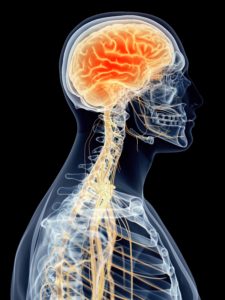Sound The Alarm: The Mind-Body Connection

It is completely normal and natural to question whether the mind-body connection truly exists. Maybe it’s just an esoteric and spiritual concept?
Indeed there is a scientific basis to the mind-body connection that is simply unavoidable due to our anatomy and physiology.
This process is initiated by a metaphorical alarm, which opens the connection between the body and mind.
Most importantly, having a clear understanding of this concept will open the doors for profound results as you continue on your Path to Performance. Please read on to learn more.
What is the alarm?
As soon as you undergo a challenge or threat more commonly known as a stressor, your body will experience a shock and resultantly sound an internal alarm. That alarm is precisely what signals your body to initiate the stress response.
Keep in mind that the stress response is simply the process by which your body uses energy and other resources to restore balance and adapt to daily obstacles.
For example, when you exercise you get small microtears within your muscles. The occurrence of these microtears sounds the alarm which initiates the stress response to begin restoring balance and heeling. The microdamage and stress response are a completely normal process, and may lead to beneficial results if the proper steps are followed to promote recovery (which will be discussed in detail in follow-up articles).
BOTH psychological and physical factors are always involved in EITHER psychological OR physical stress. Therefore a psychological stressor can cause a psychological AND/OR physical stress, and likewise a physical stressor can also cause a psychological AND/OR physical stress. So regardless of what type of stressor is occurring, BOTH psychological AND physical factors must be considered and addressed.
The mind-body connection
I ask that you please do your best to bear with me through the following technical explanation. I will be sure to follow this section with an easy-to-understand overview that helps piece everything together.
First let’s reiterate that the psychological and physical aspects of our body cannot be separated. That is because everything is connected through the nervous system.
Your nervous system is divided into the Central and Peripheral Nervous Systems. Your Central Nervous System includes the brain and spinal cord, which work as your overall control center. Everything we think, feel, and do is the result of a conscious or subconscious decision made by the Central Nervous System. It is within the Central Nervous System that a decision is made on how best to respond and ultimately adapt to an “alarm.”
The purpose of the Peripheral Nervous System is to sound the “alarm” when a circumstance meets a threshold that is determined to challenge or threaten internal balance. If the “alarm” is activated, the Peripheral Nervous System then sends that valuable information to the spinal cord and brain to allow the Central Nervous System to determine how to respond to the “alarm.” Once the brain and/or spinal cord determine what to do, they then send the orders back to the Peripheral Nervous System so that it may carry out those orders as planned.
But here’s the kicker: the subconscious and rapid decision of the brain on how best to respond to stressors is based on current, as well as past, thoughts, beliefs, experiences, and expectations. Please keep this truth in mind. If you allow it, this concept will have a massively positive and beneficial influence over future steps on your Path to Performance.
Now let’s take the time to better understand the Peripheral Nervous System, which includes numerous branches and functions.
The Peripheral Nervous System is made up of the Somatic and Autonomic Nervous System branches. The Somatic Nervous System is the aspect of the Peripheral Nervous System that is responsible for transmitting sensation and movement information back and forth between the outside environment and the Central Nervous System. This is the branch of the nervous system that is responsible for activating muscles and movements; however only if the Central Nervous System directs it to do so.
For example, if the Central Nervous System decides that the body should run, it sends a message to the Somatic branch of the Peripheral Nervous System which is then able to activate the proper muscles and movement patters that result in the action of running.
On the other hand, the Autonomic Nervous System branch is the aspect of the Peripheral Nervous System that controls involuntary actions of the body such as blood flow as well as organ function including heart rate, breathing, and digestion.
But the absolutely critical point that I want to make sure you understand is, the Autonomic Nervous System is the aspect of your nervous system that fuels your body’s stress response to a perceived challenge or threat.
The Autonomic Nervous System is further divided into Sympathetic and Parasympathetic Nervous System branches. Your Sympathetic Nervous System becomes activated upon your brain’s command to initiate the stress response.
When this aspect of your nervous system is stimulated, it causes a release of adrenalin accompanied by increased alertness and excitement. This is your body’s natural reflexive approach to responding to a perceived challenge or threat.
Think of this aspect of your nervous system as an evolutionary necessity for survival, and it is often referred to as the “Fight or Flight” response. Picture if we were being attacked by an animal, or even another human. Your Sympathetic Nervous System would kick in to either fight off the adversary or to try to escape it.
The Sympathetic Nervous System does this by increasing heart rate as well as improving blood flow and the transport of other key nutrients and substances to the areas of the body that the brain has determined need it the most for survival and adaptation at that time. Simultaneously the Sympathetic Nervous System reduces blood flow and other resources to the other areas of the body that the brain has deemed less important for immediate survival.
In some ways, you can think of the Autonomic Nervous System as fueling the desired actions of the Central Nervous System.
In summary, your Sympathetic Nervous System regulates your body’s stress response by stimulating aspects of your body required to overcome an obstacle.
Indeed it has been frequently stated that the “fight or flight” Adrenalin boost of the Sympathetic Nervous System is precisely what may make it possible for a mother to lift a car off her trapped baby.
Your body is a multi-billion dollar enterprise
To better understand the relationship between the Central Nervous System and the Peripheral Nervous System, I invite you to imagine your body as a multi-billion-dollar enterprise organization.
Think about that major multi-billion-dollar company. Typically, within organizations of this magnitude there is someone at the top, such as the CEO, that is in charge and makes the final decisions. Under the CEO there are many departments and sections, each with department heads and management.
So the order of commands in our example, from lowest to highest, includes: Department staff, which answer to the management department and department heads, which answer to the CEO.
Your body and nervous system work just like that multi-billion-dollar company. The department staff members of the company are each responsible for specific tasks and aspects of company operations. These staff members are comparable to the peripheral nervous system. When they receive key information, need help, or need to decide what to do next, they request to advise with their management by sounding the “alarm.” This opens the line of communication with the department heads which are located within the Central Nervous System.
These department heads, located within the brain of the company, surround the CEO which is also located within the brain and is the main decision maker. Upon hearing the alarm and receiving information from the department staff, the department heads organize, interpret, and then report that information to the CEO for the final decision-making process. Once the decision is made by the CEO, he or she announces the decision to the department heads, which then communicate the required actions back to each of their separate departments.
TAKE ACTION!
- Reference and review the list you completed in action steps 1 and 2 of the previous article
- Please take the time to appreciate that your mind and body always have your best interests in heart. Begin to realize that the mind-body relationships formed concerning each stressor you recorded was indeed a conscious or subconscious attempt to protect you from future pain, injury, or disappointment.
- If however the outcome was not desirable, did not effectively provide a protective purpose, and instead was actually holding you back from achieving your goals, then the next step is to ask yourself: What current and past thoughts, beliefs, experiences and expectations may have led to this reaction? Make sure to write down your insights and reflection. If nothing comes to mind, do not worry or be discouraged. Your Path to Performance is only beginning.
- Continue Step 2 of the Convergent Path to Performance by reading the follow-up articles to this post, where I explain how this mind-body connection directly relates to your performance enhancement program.
Summary
Circumstances that are determined to be a challenge or threat to internal balance within the body are known as stressors. When stressors occur, the alarm is triggered. The brain hears the alarm and learns of these circumstances through the communication between the Peripheral Nervous System and the Central Nervous System.
The process begins when the peripheral nervous system picks up information from our 5 major senses. If the peripheral nervous system picks up information that is determined to be a potential challenge or threat to the body, it sounds the “alarm” and then relays that information to the Central Nervous System.
There, the brain learns of these circumstances and makes the final decision of whether or not the circumstances are indeed a challenge or threat worthy of being considered a stressor. Once this decision is made, the brain then determines how best to deal with those stressors.
The brain’s subconscious and rapid interpretation and decision is based on current, as well as past, thoughts, beliefs, experiences and expectations.
This unavoidable, constant, and repetitive “back and forth” between the brain of the Central Nervous System and the remainder of the physical body controlled by the Peripheral Nervous System is precisely why we are unable to separate the psychological and physical aspects of stress.
In simpler terms, there are psychological and physical aspects to all stress, regardless of whether the initial stressor was psychological or physical in nature.

Dr. Eugene Ketselman PT, DPT, Cert. MDT, CSCS
Dr. Eugene Ketselman is a licensed Physical Therapist, Certified Strength and Conditioning Specialist, Performance Coach, and owner of Convergent Movement and Performance; Home of where Physical Therapy, fitness, and performance training converge! Dr. Ketselman's mission is to help motivated athletes and active adults excel in their passions by maximizing physical performance and reducing setbacks from pain and injury.
Here at Convergent Movement and Performance, we practice what we preach. You know we are a good match for one another as soon as you find yourself relating to the content we provide. Be sure to click below to learn more.
Do you have specific questions that aren’t answered on this website?
Click below
Does pain, weakness, or exhaustion prevent you from reaching your FULL potential while performing the activities you love?
Click below
Do you love what you’re seeing, but still aren’t sure if you can make the commitment?
Click below
Contact Us
Convergent Movement and Performance serves out of Northern – Central New Jersey, conveniently located to those that live, work, and travel in the nearby towns of Warren, Bridgewater, Martinsville, Watchung Hills, Bedminster, Basking Ridge, Bernardsville, Chatham, Westfield, and Piscataway within Somerset, Morris, Union, and Middlesex counties, NJ.
